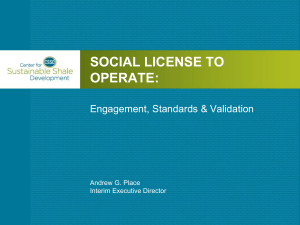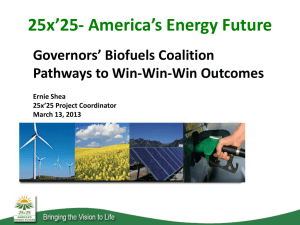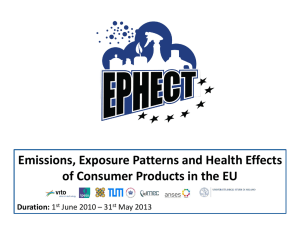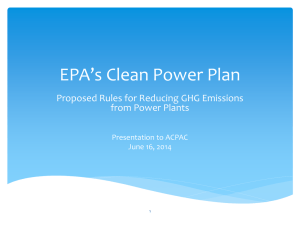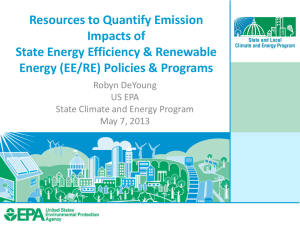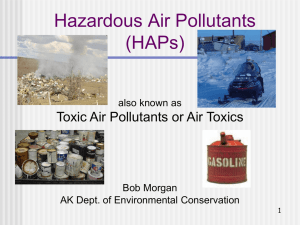Marcellus Shale Citizen Surveillance and
advertisement
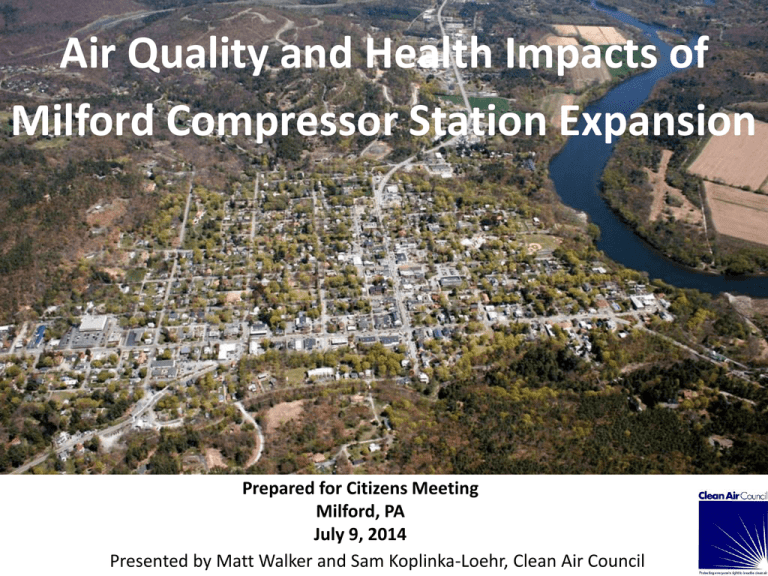
Air Quality and Health Impacts of Milford Compressor Station Expansion Prepared for Citizens Meeting Milford, PA July 9, 2014 Presented by Matt Walker and Sam Koplinka-Loehr, Clean Air Council Clean Air Council Marcellus Shale Program • • • • Lawsuits against polluters or agencies Track current rulemaking and write comments on regulations Work with residents to comment and testify on natural gas equipment Community actions to achieve goals outside of regulatory pathways Presentation Overview • Introduction • Health Impacts from Pollutants • Milford Station Specifics • How Residents can Protect Public Health Photo Source: Bob Donnan: http://www.donnan.com/EPA_Air-Quality_92711.htm 64% of PA is above Marcellus Shale. In 2013, PA had over 6,000 wells with 3 trillion cubic feet of gas production. These gas products have flooded regional markets and companies are trying to build infrastructure to expand. PA Pipelines and Compressor Stations Milford Compressor Station is currently one of 10 major pipeline expansion projects in the Delaware River Watershed. Air Pollution Sources Dallas Fort Worth In 2009, the gas industry released more smog-forming emissions than all cars and trucks in the Dallas metro area – New York Times article citing Armendariz’s 2009 report, supported by Texas Commission on Environmental Quality http://www.nytimes.com/gwire/2011/05/27/27greenwire-could-smog-shroud-the-marcellus-shales-natural-3397.html?pagewanted=all RAND 2013 Air Pollution Study • Research and Development finds shale gas air pollution damages already between $7.2 and $30 million in PA. – Health damages: increased asthma, hospitalization, premature death. – Physical damages: agriculture and infrastructure. – Compressor stations accounted for 60–75% of the total damages. Biggest NOx Contributors Adapted from Allen Robinson, http://iom.edu/~/media/Files/Activity%20Files/Environment/EnvironmentalHealthRT/2012-Apr-30/Robinson.pdf Biggest VOC Contributors Adapted from Allen Robinson, http://iom.edu/~/media/Files/Activity%20Files/Environment/EnvironmentalHealthRT/2012-Apr-30/Robinson.pdf Health Impacts from Pollutants Pollutants from Compressor Stations Potential Health Impacts from Nitrogen Oxides (NOx) • Low levels – eye, nose, throat & lung irritation – coughing, shortness of breath – tiredness, nausea • High levels – rapid burning, spasms, and swelling of throat and upper respiratory tract – reduced O2 in tissues – fluid build-up in lungs Source: http://www.atsdr.cdc.gov/toxfaqs/TF.asp?id=396&tid=69 Potential Health Impacts from Hazardous Air Pollutants (HAPs) – Includes known and suspected carcinogens – Skin, eye, nose, and throat irritation; headaches, loss of coordination, nausea; damage to liver, kidney, and central nervous system over time. VOCs: http://www.epa.gov/iaq/voc.html, Formaldehyde: http://www.atsdr.cdc.gov/tfacts111.pdf , Hydrogen Sulfide: http://www.atsdr.cdc.gov/toxfaqs/tf.asp?id=388&tid=67 Potential Health Impacts from Fine Particulate Matter • Short-term exposure – Eye, nose, and throat irritation • Long-term exposure – Increase in risk of cancer – Exacerbates lung disease Potential Health Impacts from Ozone • Aggravation of asthma, bronchitis & emphysema and increased susceptibility to pneumonia & bronchitis • Linked to bladder, breast, and lung cancers, stroke, diabetes, lung damage, and premature death • Throat irritation, congestion, coughing, and chest pain • Wheezing and breathing difficulties Source: http://www.epa.gov/air/ozonepollution/health.html American Lung Association, “Health Effects of Ozone and Particle Pollution,” State of the Air, 2011; President’s Cancer Panel, Reducing Environmental Cancer Risk: What We Can Do Now, 2008-2009 Annual Report (National Cancer Institute, May 2010). Cumulative Health Impacts • Taken together, emissions from shale gas infrastructure have substantial public health ramifications. – In their 2013 study, McKenzie et al. found elevated risk of birth defects in populations residing within a one-mile radius of gas infrastructure. – Environmental Assessment of East Side Expansion should consider impacts at the points of gas extraction and refining as well. Milford Compressor Station Impacts Columbia Pipeline Group’s Application • Federal Energy Regulatory Commission and Pennsylvania DEP. • Includes reductions for removing existing engines that have operated at a fraction of permitted capacity. – Less than 200 hours/year since 2004. • Actual emissions will be much higher than previously emitted in the neighborhood. Columbia Pipeline Group’s Application with Reductions Columbia Pipeline Group’s Actual 2012 Milford Emissions Columbia Pipeline Group’s Actual 2012 Hours of Operation 90x Increase in Milford Station Emissions tons/year 2012 Carbon Dioxide Carbon Monoxide 125 0.55 Projected 50,762 50.64 NOx Particulate Matter 0.46 - 42.29 6.37 VOC Formaldehyde Sulfur Dioxide 0.02 - 3.09 0.42 0.31 Source: 2014 Columbia Pipeline Group DEP Application Expected Air Pollution Sources • • • • • • • • 2 Natural Gas Turbines Emergency Generator Heater Construction Fugitive Emissions Blowdowns 90 Barrel Condensate Tank 45 Barrel Waste Liquid Tank EPA’s New Oil and Gas Standards • On Aug. 2, 2013, EPA updated its performance standards for storage tanks. – All tanks subject to the NSPS must control VOC emissions by 95 percent. Fugitive Emissions/Leakages Leakage from Compressor Stations. Source: EPA Fugitive Emissions • Columbia states greenhouse gas fugitive emissions will be 208 tons at Milford, and 2,847 tons over the entire project. • A 2009 survey of the emissions from natural gas activities in Texas’s Barnett Shale estimates that fugitive emissions from transmission account for 35% of total fugitive emissions from natural gas activities, or 0.49% of gross production. • Columbia has not stated what emissions are expected from venting condensate and liquid waste tanks How Residents Can Protect Public Health Regulatory Timeline • Currently in 30-day comment period for DEP Plan Approval until July 28th • FERC plans to release draft Environmental Review on August 29th, 2014 – Followed by period of agency and public review – Columbia has requested FERC release the EA early, on July 15th • Interveners have opportunity for discovery and appeal Comment talking points for DEP • Public Hearing Request • Best technologies/practices – Blowdown Injection – Electric Compressors – Hazardous Material Management Plan – Condensate Tank Emission Analysis Comment talking points for Potential Public Hearing • Are the greenhouse gas emissions from the station properly accounted for in the current air permit? • Has DEP performed a proper aggregation analysis on this station and other facilities? • What will the air monitoring and stack test requirements be for this facility? • Columbia states aboveground condensate and liquid waste storage is “insignificant,” what hazardous waste oversight will there be of the 90 and 45 barrel tanks? • Ask how often will the station be inspected. Electric Compressors • Electrical hookup present • Would greatly reduce emissions • Depending on gas prices, can pay back within 3 years Re-routing Blowdown Gas • EPA standards recommend rerouting blowdown gas into sales lines or intersecting pipelines rather than doing an atmospheric release • Would greatly reduce emissions • Depending on gas prices, can pay back within 2 years Comment talking points for FERC • A true cumulative air quality/health impacts analysis. • A true cumulative climate impacts analysis. • Analysis of fugitive methane and VOC emissions. • Pursuant with NEPA, the Environmental Impact Statement must take into account all impacts whether “direct, indirect, or cumulative.” Clean Air Council Action Alert on Milford Station Reality Check on Regulatory Process Contact Info • Matt Walker, CAC Community Outreach Director mwalker@cleanair.org • Sam Koplinka-Loehr, CAC Shale Gas Organizer SKL@cleanair.org Questions? Air Regulations and Permitting General Permit 5 (GP-5) • PA DEP released the revised General Permit 5 in 2013 – Claimed large reductions in air pollution – Reality is that new requirements only matches what the industry has already been doing for the past two years • Stream-lined permit • Severely limits public participation Federal Regulations Clean Air Act – What can be in the air? • EPA sets NAAQS based on Public Health • National Emission Standards for Hazardous Air Pollutants (NESHAPS) • New Source Performance Standards (NSPS) – EPA’s new Oil and Gas Regulations – Required Technology • Nonattainment New Source Review • Prevention of Significant Deterioration – Title V Permit Program State Air Quality Permitting • State permits enforce state and federal regs • Exemptions (PA) – All equipment except engines at compressor stations > 100 hp • State permits (minor sources) – Plan approval (construction) – Combined operating permit and Plan Approval (GP5) • Federal Permits (major sources) – Title V • DEP is required to seek public input on compressor stations Greenhouse Gas Tailoring Rule • Methane (nat gas) = 21 x more potent than CO2 (leaking/venting) • CO2 from engines • Can trip Title V “major source” permit – 100,000 tpy CO2e limit for new or modified site – EPA’s “phase 3” of rule would lower this to 50,000 tpy CO2e Truck Traffic NOx, PM, CO2 Dehydration Units Methane, VOCs, HAPs Condensate Tanks VOCs & HAPs Flaring/Venting Source: Frank Finan HAPs, CH4 Unplanned Events 2012 Lathrop Compressor Station Explosion, Susquehanna County

